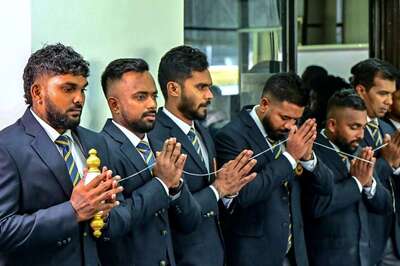
views
To RSS leaders, early on, Ram Mandir seemed to be too local an issue even on the state level. But when their attempts with ‘Swadeshi’ and ban on cow slaughter failed to get the sort of mass appeal they wished for, through a process of trial-and-error, the Sangh finally zeroed in on Ram Mandir as it resonated with the people, explains one of the foremost scholars on RSS, Shridhar Damle.
In this conversation with News18, Damle, who has co-authored a book on the RSS with American scholar Walter Anderson - ‘RSS: A view to the inside’, charts out the history of how Ram Mandir came to occupy the centre stage in the Sangh.
He predicts that instead of shifting focus to Mathura or Kashi, the Sangh will now try to expand its reach in rural India through a pan-India fund-collection drive for Ram Mandir, and he talks about the legacy that Mohan Bhagwat will leave behind.
Could you give us an idea of how Sangh took up the issue of Ram Janmabhoomi?
RSS actually started to mobilise people not on the issue of Ram Mandir initially, but on the issues of Swadeshi and ban on cow slaughter. The issue of Ayodhya, and I’m talking about late 40s and early 50s, seemed to be too local an issue to them, even for Uttar Pradesh.
On cow slaughter ban, they were able to travel through the country for a signature campaign and get as many as 1.75 crore signatures. It was a first-of-its-kind exercise for the RSS. They were able to connect with a lot of people, a lot of princely states and the Hindu religious leaders through this.
Before 1967 parliamentary and assembly elections, MS Golwalkar (second RSS chief) again mobilised his cadres on the cow slaughter issue, but the issue was hijacked by ambitious leaders like Mahant Avaidyanath of Gorakhnath math and Karpatri Maharaj, founder of Ram Rajya Parishad.
Then in 1983, a senior Congress leader and several times cabinet minister in UP governments, Dau Dayal Khanna, in a speech made on a VHP platform said that mosques in Mathura, Kashi and Ayodhya had to go. He said it in a meeting where among those present was Rajendra Singh (also known as Rajju Bhaiyya who would go on to become a Sarsanghchalak) and interim Prime Minister, senior Congress leader Gulzarilal Nanda.
Afterward in multiple pracharak meetings, held in Uttar Pradesh and Rajasthan, the issue of Ram Mandir was raised before the then Sangh chief, Balasaheb Deoras. This is how Champat Rai recalled Deoras responding to the pracharak, in a piece he wrote for the organiser, “Oh, are the locks [on the temple] still there?”
It was a hint enough for pracharaks to consider a long agitation against Babri Masjid. Deoras reportedly told pracharaks that they should begin an agitation on Ram Mandir issue only if they were prepared to fight for it for the next three decades. He told them that it was “a fight of the nerves.” Those who held their nerves till the end would win this battle.
Their next move was to start a pan-India movement, on the lines of the signature campaign they had carried out for cow slaughter ban, the VHP-organised Ekatmata Yatra. This was the idea of RSS leader Moropant Pingle, who was one of trustees of VHP.
The swayamsevaks had planned to sell three lakh Ganga jal bottles during four cross-country yatras to raise money for construction of a Ram temple. But they ended up selling all the Ganga Jal bottles in UP alone. Such was the resonance of the issue, which surprised some of the Sangh leaders themselves.
The Sangh raised nearly Rs 8 crore out of the campaign. But more importantly, from their point of view, they were able to expand their reach to grassroots level. Slowly the RSS was realising the Ram Janmabhoomi issue had a much bigger appeal than anything else.
In 1984, they also got large banners showing Ram Lalla behind the locks, put up on around 40 trucks, which travelled throughout Uttar Pradesh. Moropant Pingle also initiated the worship of Ram brick (Ram Shila pujan for Ram Mandir which was done in more than three lakh villages and towns). Subsequently, of course, in 1989, the issue was formally taken up by the BJP in their Palanpur resolution.
So now that the RSS has been able to realise their two big missions - removal of Article 370 and getting Supreme Court’s nod to build Ram Mandir in Ayodhya, what is going to be the next big agenda… Uniform Civil Code?
I think Uniform Civil Code, important as it is, is going to remain, for the time being, an urban issue. There will be discussion on it surely, maybe even in the Parliament, on television. But RSS focus will be on improving its hold in the rural belt. I think one way to do that could be to mobilise people from across social sections, across caste and class divides, for donations to build a grand Ram Temple.
Do you think RSS will pick up the issues of Mathura and Kashi in near future?
I don’t think so. I think their focus will be for at least the next 3-4 years on Ram Mandir only. Maybe after that some voices will be raised on that front also.
Soon it will be time for Mohan Bhagwat to make way for his successor. Having realised his organisation’s goals of Article 370 and Ram Mandir, what sort of legacy does he leave behind? In stature, do you think he’ll be considered larger than his predecessors, say K Sudarshan or Rajendra Singh?
The Sangh does not work like this. They don’t make larger-than-life personal heroes like this. Rajju Bhaiyya and K Sudarshan both suffered from ailments, it isn’t proper to compare them with Mohan Bhagwat. And I think it will be many years before the RSS begins to celebrate his achievements.
For now, the RSS is working to popularise their three ideological icons like Deen Dayal Upadhyay, MS Golwalkar, and Dattopant Thengadi, whose birth centenary RSS is marking this year. Also, the RSS is working on highlighting the contributions of Balasaheb Deoras and Bhaurao Deoras, Nanaji Deshmukh and Moropant Pingle. Actually, it was Balasaheb Deoras that laid three rules for the RSS chiefs in a bid to avoid creating larger-than-life personas for them - Sarsanghchalaks will retire at 75, get a private citizen’s funeral, and apart from photographs of Golwalkar and Hedgewar, there will not be photos of any other Sangh leader at RSS events.
But as far as Mohan Bhagwat is concerned, I think his legacy will built around four main achievements
- To transform BJP in such a fashion so that Narendra Modi can come and take over the party.
- To make Hindutva mainstream, so that people aren’t shy of claiming it for themselves.
- Clearing decks for construction of Ram Mandir
- Presiding over the expansion of RSS and making it largest Hindu organisation in the world.


















Comments
0 comment